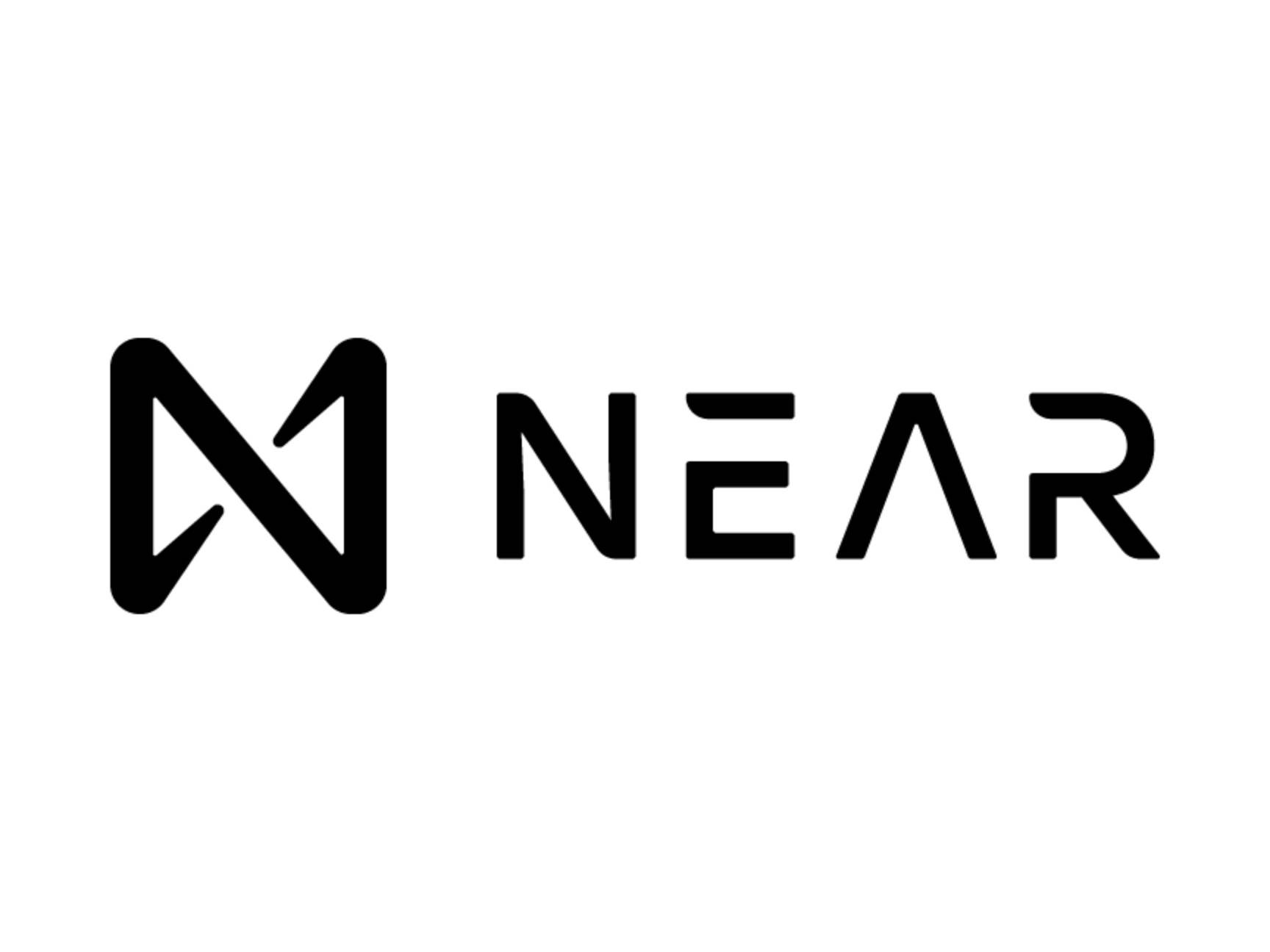위키 구독하기
Share wiki
Bookmark
NEAR Protocol
NEAR Protocol
NEAR 프로토콜(NEAR protocol)은 레이어 1 블록체인으로 지분 증명 합의 메커니즘을 사용하여 탈중앙화 애플리케이션 개발을 가능하게 합니다. 일리아 폴로수킨과 알렉스 스키다노프에 의해 설립되었으며, 네트워크 내 거래 수수료 및 저장 비용에 사용되는 네이티브 토큰인 NEAR을 가지고 있습니다. NEAR 프로토콜의 메인넷은 2020년 4월에 출시되었고, 2020년 9월에는 커뮤니티 운영으로 전환되었습니다. [1] [2]
개요
NEAR 프로토콜은 블록체인의 확장성 문제를 샤딩 구현을 통해 해결합니다. 샤딩은 네트워크를 샤드라고 하는 더 작은 부분으로 나누어 네트워크의 계산 부하를 줄이는 방법입니다. 네트워크의 각 노드는 자체 샤드와 관련된 코드만 실행하므로 서로 다른 샤드가 병렬로 정보를 처리할 수 있습니다. 이를 통해 네트워크는 더 많은 트랜잭션을 처리하고 네트워크 노드 수가 증가함에 따라 확장성을 높일 수 있습니다. [1]
2024년 1월 30일, NEAR 프로토콜은 샤딩 2단계의 테스트 출시를 발표했습니다. 2단계는 NEAR의 핵심 프로토콜 아키텍처에 대한 근본적인 업그레이드를 도입하여 네트워크의 확장성과 분산성을 높입니다. 또한 상태 비저장 검증(stateless validation) 구현 방식을 변경합니다. 이는 상태 변경, 즉 블록체인에 게시된 모든 데이터의 상태를 업데이트하는 프로세스에 대한 혁신적인 접근 방식입니다. NEAR 검증자는 더 이상 샤드의 상태를 로컬에서 유지할 필요가 없으며 네트워크에서 상태 변경을 검증하는 데 필요한 모든 정보, 즉 "상태 증인(state witness)"을 검색할 수 있습니다. [22]
"NEAR는 10억 명 이상의 사용자에게 확장 가능한 체인 추상화(Chain Abstraction) 인프라를 구축하기 위해 꾸준히 발전하고 있습니다."라고 NEAR 프로토콜 공동 설립자이자 NEAR 재단 CEO는 말했습니다. "상태 비저장 검증을 통한 확장성 개선은 멀티체인 DeFi 스타일 dApp이든 주류 사용자를 위한 dApp이든 더 많은 최종 사용자 애플리케이션에 더 나은 사용자 경험을 제공할 수 있습니다."
블록체인 운영 체제 (BOS)
2023년 3월 2일, NEAR는 자체 플랫폼이 블록체인 운영 체제(BOS)가 되고 있음을 발표했습니다. BOS는 업계 최초의 범주로, 어떤 블록체인과도 호환되는 개방형 웹 경험을 찾아보고 검색하기 위한 공통 계층입니다. 이 프레임워크는 모든 블록체인과 호환되며 NEAR는 공통 진입점 역할을 할 것이라고 CoinDesk와의 인터뷰에서 Polosukhin이 밝혔습니다. [27] [28]
"구성 가능한 분산형 프런트엔드는 프레임워크로서 모든 Web2 또는 Web3 백엔드 및 모든 지갑과 함께 작동할 수 있습니다."라고 Polusukhin은 말했습니다. "미래에는 원활한 브리징을 통해 한 체인의 지갑을 다른 체인과 상호 작용하는 데 사용할 수 있도록 제공할 것입니다."라고 그는 덧붙였습니다. "우리는 계층 1에 대한 집중에서 벗어나 사용자와 그들이 경험하는 경험에 중점을 두고 있습니다. 우리는 이것을 일반적인 블록체인의 프런트엔드로 보고 있습니다."
나이트셰이드
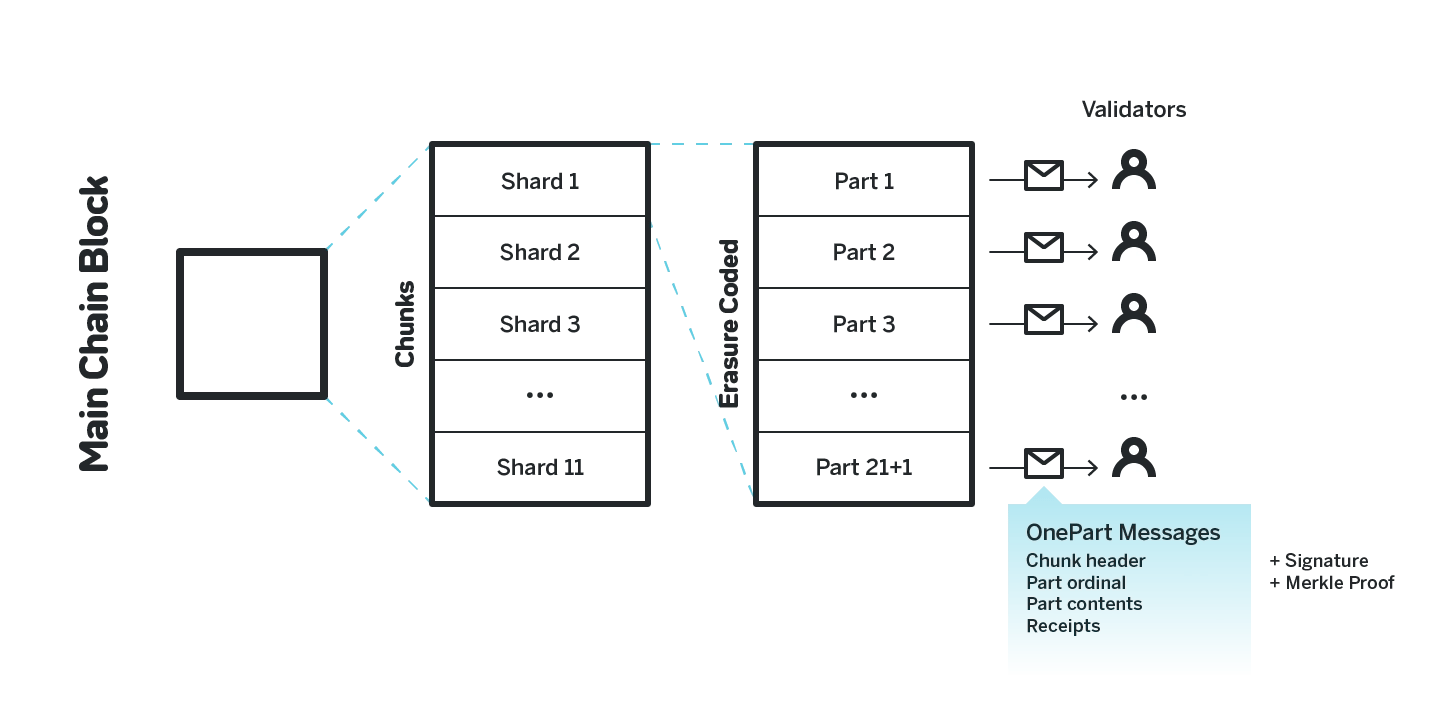
NEAR 프로토콜은 트랜잭션 처리량을 향상시키기 위해 나이트셰이드(Nightshade)라는 기술을 사용합니다. 나이트셰이드는 여러 개의 분할된 체인에서 검증자 그룹이 동시에 트랜잭션을 처리하는 일종의 샤딩으로, 블록체인의 전체 용량을 증가시킵니다. 기존의 샤딩과 달리, 나이트셰이드는 "청크(chunk)"라고 불리는 다음 블록의 작은 부분들을 생성합니다. [4]
이를 통해 NEAR는 초당 최대 10만 건의 트랜잭션을 처리하고 1초의 블록 시간으로 거래에 대한 거의 즉각적인 최종성을 달성하면서 낮은 트랜잭션 수수료를 유지할 수 있습니다. [4]
무지개 다리
Aurora가 만든 도구인 무지개 다리를 사용하여 이더리움(Ethereum)(https://iq.wiki/wiki/ethereum)과 NEAR 간에 자산을 주고받을 수 있습니다. 이 도구는 이더리움(Ethereum)(https://iq.wiki/wiki/ethereum), Aurora, 그리고 NEAR(https://iq.wiki/wiki/near-token) 간에 ERC-20 자산을 이동할 수 있게 해줍니다. [12]
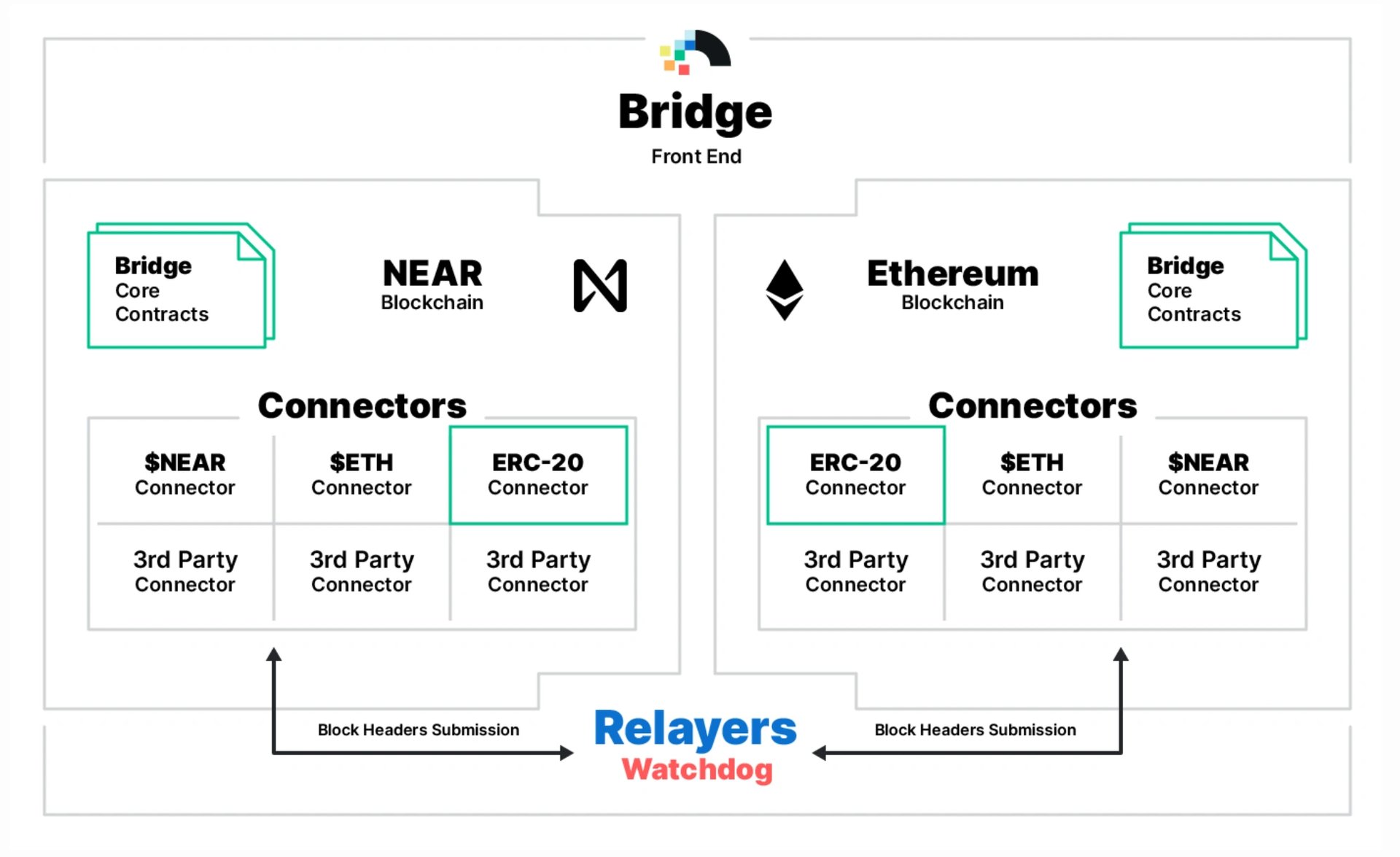
USDT, DAI, TUSD와 같은 인기 있는 ERC-20 토큰, 스테이블코인 (WBTC, WETH와 같은 래핑된 자산, DEX 토큰 (UNI, 1INCH), 대출 토큰 (AAVE, COMP), 그리고 서비스 회사 토큰(HT, CRO)은 NEAR와 호환됩니다. 이러한 토큰은 MetaMask 또는 다른 Web3 지갑과 NEAR 지갑 및 앱 간에 직접 전송할 수 있으므로 두 플랫폼 간의 원활한 상호 운용성을 제공합니다. [13]
Doomslug
Near Protocol은 비잔틴 장애 허용 (합의 메커니즘)의 자체 버전인 Doomslug을 사용하며, 추가적인 보안을 위해 최종성 가젯을 사용합니다. 이는 위임 지분 증명 (DPoS) 메커니즘의 변형으로, 네트워크가 단 한 번의 확인 라운드만으로 실질적인 최종성을 달성할 수 있도록 합니다. [14]
NEAR의 Doomslug은 두 가지 형태의 최종성을 구분합니다. 악의적인 검증자가 처벌받지 않는 한 사전 투표를 받은 블록은 취소될 수 없으므로 Doomslug 최종성이 달성되고, Tendermint 또는 HotStuff와 유사하게 블록 생성자의 2/3가 사전 투표 및 사전 커밋을 완료하면 BFT 최종성이 달성됩니다. [15]
NEAR 토큰 (NEAR Token)
NEAR 토큰은 Near Protocol의 네이티브 암호화폐이며, 트랜잭션 수수료 지불 및 스토리지 비용 지불 등 다양한 기능에 사용됩니다. 또한, 토큰 보유자는 스테이킹을 통해 트랜잭션 검증 및 네트워크 합의에 참여할 수 있습니다. [1]
NEAR 토큰의 주요 용도는 트랜잭션 수수료 지불 및 블록체인 상 데이터 스토리지에 대한 담보 제공입니다. 또한 트랜잭션 처리 및 데이터 저장에 사용되는 계정 단위를 제공합니다. [30]
토큰 경제학
처음 생성 당시 10억 개의 NEAR 토큰이 생성되었으며, 그 할당은 여러 그룹으로 나뉩니다. 17.20%는 커뮤니티 지원금 및 프로그램에, 14.00%는 핵심 기여자에게, 12.00%는 커뮤니티 판매에, 11.76%는 초기 생태계에, 11.40%는 운영 지원금에, 10.00%는 재단 기금에, 15.23%는 시드 라운드에, 8.41%는 벤처 라운드에 할당됩니다. 이러한 할당은 Near 프로토콜 생태계의 다양한 이해 관계자를 지원하고 인센티브를 제공하도록 설계되었습니다. [3]
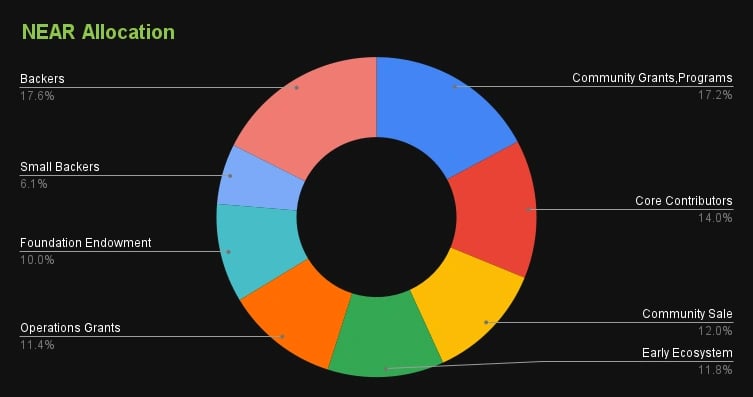
NEAR 재단
2020년 4월 22일에 설립된 NEAR 재단은 스위스에 기반을 둔 비영리 단체로, NEAR 생태계를 주도하는 적극적인 참여자 그룹인 NEAR 컬렉티브의 미션을 지원하기 위해 재정 및 운영 자원을 활용합니다. [5] 그 미션은 다음과 같습니다.
…개발자와 크리에이터의 커뮤니티를 육성하고 지원함으로써 전 세계가 개방형 기술로 전환하는 것을 가속화하는 것.
반면, 재단의 비전은 다음과 같습니다.
…크리에이터, 개발자, 기업가, 커뮤니티 구성원 및 토큰 보유자로 구성된 자급자족적인 생태계로, 이들의 협력적인 노력을 통해 NEAR 생태계가 개방형 웹에서 막대한 영향력을 미치는 프로젝트를 구축하는 최고의 장소가 되는 것.
NEAR 재단은 2023년 11월부터 AI 혁신가 일리아 폴로수킨이 CEO로 임명되어 이끌고 있습니다. 그는 NEAR 개방형 웹 생태계의 성장을 감독하고 dApp 구축을 위한 플랫폼으로 NEAR를 활용하는 여러 팀을 지휘합니다[25]. 임명 당시 그는 다음과 같이 언급했습니다.
"NEAR 재단에 공식적으로 합류하고 개방형 웹이라는 공동의 비전을 향해 생태계와 함께 계속해서 노력하게 되어 영광이고 기쁩니다."라고 일리아 폴로수킨은 자신의 새로운 역할에 대해 말했습니다. "분산형 생태계를 효과적으로 조율하는 데는 많은 반복과 실험이 필요하며, NEAR가 처음부터 이 과정을 개선하기 위해 노력해 온 것을 자랑스럽게 생각합니다. 공동 진화의 다음 단계를 통해 각 분야를 더 빠르게 구축하고 더 효율적으로 협력할 수 있을 것이라고 믿습니다."
2024년 1월 11일, NEAR 프로토콜은 마케팅, 사업 개발 및 커뮤니티 팀을 중심으로 약 35명의 직원에게 영향을 미치는 약 40%의 감원을 발표했습니다. 이는 NEAR 재단 이사회(NFC)와 함께 실시한 검토 결과 재단이 기대만큼 효과적이지 못하다는 사실을 발견한 데 따른 것입니다. [18] [27]
"이 검토를 거쳐, 더 좁고 더 큰 영향을 미치는 활동에 집중하기 위해 핵심 재단 팀을 상당히 통합하기로 결정했습니다." - NEAR 재단 CEO 일리아 폴로수킨
2024년 4월 8일, NEAR 재단은 NEAR의 핵심 인프라 강화를 목표로 하는 새로운 계획인 인프라 위원회를 출범했습니다. 인프라 프로젝트에 400만 달러를 배정한 이 계획은 개방적이고 투명한 방식으로 자금을 배분하고 프로젝트를 조달하여 NEAR 프로젝트의 성공을 지원하기 위한 것입니다. 핵심 인프라에는 RPC 노드, 릴레이어, 인덱서, 브리지, 지갑, 부하 분산기 및 오라클이 포함됩니다. [31]
NEAR 재단 이사회
NEAR 재단 이사회(NFC)는 NF의 최고 의사결정 기구(이사회와 유사)로, NF에 대한 최종적인 통제 및 감독과 조직에 대한 중요한 의사결정을 담당합니다. [34]
이사회 구성원으로는 Diogo Monica, Illia Polosukhin, Sheila Warren, Chris Donovan, 그리고 Richard Muirhead가 있습니다. [34]
NEAR.AI의 마스터 플랜
2024년 6월 18일, NEAR 재단 산하 프로젝트인 NEAR.AI는 오픈소스 및 사용자 소유 인공 일반 지능(AGI, Artificial General Intelligence) 개발을 목표로 하는 계획을 발표했습니다. 이 프로젝트는 기계에게 코딩을 가르치는 AI 개발자(AI Developer)를 만든 후 이러한 기술을 활용하여 AGI를 발전시키는 AI 연구원(AI Researcher)을 만드는 것으로 시작됩니다. 광범위한 사용자 기반, 개발자 커뮤니티 및 재정적 자원을 보유한 NEAR 생태계는 이러한 비전을 달성하는 데 유리한 위치에 있습니다. 이 계획은 오픈소스로 구축하여 사용자 소유권과 개발된 AI에 대한 제어를 보장하고 투명하고 협력적인 개발 프로세스를 촉진합니다.
NEAR의 초기 제품은 사용자 친화적이고 널리 채택된 확장 가능한 블록체인입니다. 장기적인 목표는 사용자 소유 AI(User-Owned AI)를 통해 사람들이 자신의 자산, 데이터 및 선택을 제어할 수 있도록 하는 것입니다. 이는 사용자의 이익을 극대화하면서 개인 정보와 보안을 유지합니다. 이 AI는 개별 사용자, 커뮤니티 및 브랜드에 맞게 사용자 지정할 수 있으며 중개자 없이 직접 거래를 가능하게 합니다. Alex Skidanov가 이끄는 NEAR.AI 팀은 Web3 애플리케이션을 포함한 안전한 엔드투엔드 애플리케이션 개발을 위한 AI 개발자 구축에 중점을 둡니다.
블록체인의 중요한 과제 중 하나는 여러 체인에 걸친 분열과 개발자 수의 제한입니다. NEAR.AI는 AI 개발자를 사용하여 Web3 제품 생성을 단순화하여 비용을 절감하고 개발을 더욱 쉽게 만들고자 합니다. 이 프로젝트는 오픈소스로 유지되며 효율성과 혁신을 높이기 위해 더 넓은 커뮤니티와 협력합니다. NEAR 커뮤니티에 참여하고 기존 NEAR 토큰 기반 경제를 활용하여 NEAR.AI는 더 많은 개발자와 사용자를 유치하고 새로운 경험과 경제적 기회를 창출하고자 합니다.
AI 추론, 검색 및 공식 방법의 발전은 AGI를 향한 NEAR.AI의 진행 상황을 주도할 것입니다. 궁극적인 목표는 어떤 작업에 대해서도 전문가 수준의 인간 능력을 능가하고 생산성과 창의성을 향상시키는 사용자 소유 AGI입니다. 이 기술은 대기업이나 정부가 아닌 개인과 커뮤니티가 소유하게 되어 모든 AI 및 AGI 개발이 모든 사람에게 이익이 되고 오픈소스로 유지되도록 합니다. [20]
파트너십 및 협업
NEAR 프로토콜 x 구글 클라우드
NEAR 프로토콜은 2022년 10월 4일, 웹3 스타트업을 가속화하기 위한 구글과의 전략적 파트너십을 발표했습니다. NEAR 지원금 수혜자들은 구글 클라우드로부터 기술 지원을 받게 됩니다. [8]
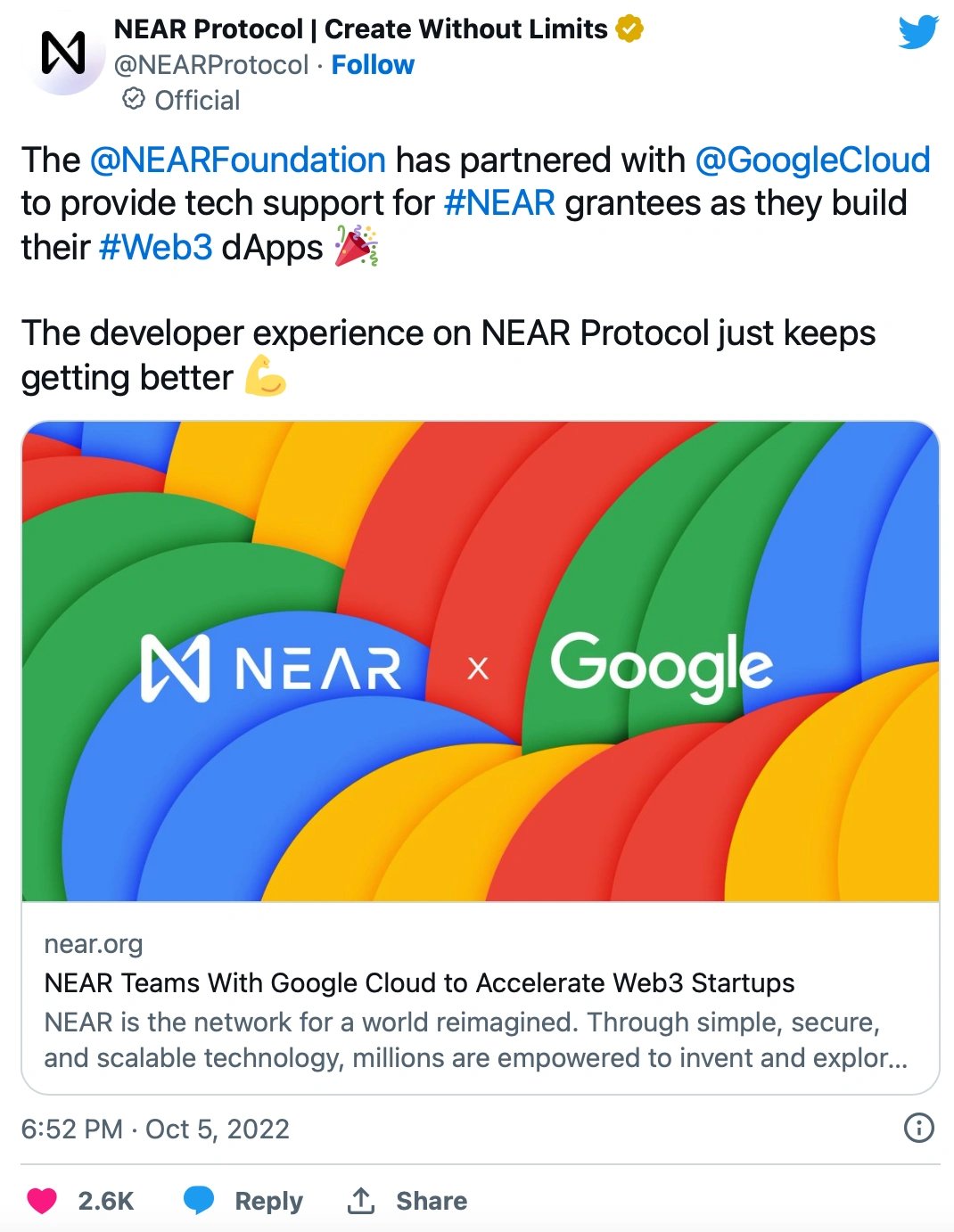
구글 클라우드는 NEAR 프로토콜에서 웹3 프로젝트와 dApp을 구축하고 확장하는 개발자들을 지원합니다. 개발자들은 구글 클라우드를 통해 핵심 인터넷 인프라를 활용하여 코드를 빠르고 안전하게, 원활하게 배포할 수 있습니다. 이 파트너십을 통해 NEAR 프로젝트는 확장성을 달성할 수 있습니다. [8]
"NEAR을 지원하고 웹3 개발자들에게 가장 안전하고, 안정적이며, 지속 가능한 클라우드 인프라를 제공하여 그들이 블록체인 기반 플랫폼에서 새로운 제품과 서비스를 구축하고 확장할 수 있도록 지원을 계속할 것입니다." - 구글 클라우드 디지털 자산 담당 이사 Carlos Arena
NEAR 프로토콜 x SeatlabNFT
SeatlabNFT는 NEAR 블록체인 기반의 NFT(대체불가토큰)(non-fungible token)-기반 이벤트 티켓팅 마켓플레이스입니다. NEAR의 샤딩 아키텍처인 Nightshade는 확장성 문제를 해결하는 데 도움이 되어 성능에 부정적인 영향을 미치지 않고 많은 수의 트랜잭션을 처리할 수 있습니다.
SeatlabNFT를 통해 아티스트는 스캘퍼를 거치지 않고 팬들에게 직접 이벤트 티켓을 만들고 판매할 수 있으며, NFT 기술을 통해 티켓의 진위를 보장합니다. 이를 통해 구매자는 높은 가격을 지불할 필요가 없으며 원본 티켓을 소지할 수 있습니다. [9]
NEAR Wallet x SWEAT
런던에 기반을 둔 기술 회사 Sweatcoin은 신체 활동을 장려하여 건강한 삶을 증진시키는 것을 목표로 하며, 혁신적인 새로운 토큰인 SWEAT을 출시하기 위해 NEAR Foundation(니어 파운데이션)과 손을 잡았습니다. [10]
“Sweatcoin은 건강을 통해 새로운 부의 경제를 창출하겠다는 비전으로 설립되었습니다. 1,000걸음을 걸을 때마다 Sweatcoin을 얻을 수 있으며, 앱에서 Sonos 및 Reebok과 같은 브랜드의 상품 및 서비스와 교환하거나 Sweatcoin for Good을 통해 Save the Children과 같은 중요한 자선 단체에 기부할 수 있습니다.” - Anton Derlyatka, Sweatcoin 공동 설립자
NEAR 재단 x 바이낸스 커스터디
2022년 11월 7일, NEAR 재단은 기관 투자자를 위한 안전한 디지털 자산 보관 솔루션인 바이낸스 커스터디(Binance Custody)와의 통합을 발표했습니다. 이제 NEP-141 표준이 지원되어 NEAR를 보유한 모든 기관 투자자가 안전한 저장 인프라를 사용할 수 있습니다. 또한, 이 통합을 통해 바이낸스 커스터디는 NEAR 기반 프로젝트에서 NEP-141과 호환되는 토큰에 대한 지원을 더욱 간편하게 제공할 수 있습니다. [30]
NEAR 재단 x 그루포 누트레사
NEAR은 남미의 주요 식품 가공업체인 그루포 누트레사(Grupo Nutresa)와 파트너십을 맺고 블록체인 기술을 식료품 업계에 도입했습니다. 그루포 누트레사는 NEAR 블록체인 상에 최초의 오픈소스 로열티 포인트 프로그램 중 하나를 만들어 콜롬비아와 라틴 아메리카에서 최종적으로 100만 명의 사용자에게 서비스를 제공할 예정입니다. 이 파트너십은 기술 회사인 피어시스트(Peersyst)의 지원을 통해 성사되었습니다. [11]
NEAR 재단 x 메타 풀
2024년 2월 7일, NEAR 기반으로 구축된 유동적 스테이킹 솔루션인 메타 풀은 NEAR 재단과 협력하여 엔터프라이즈 노드 운영자(ENO) 프로그램을 시작했습니다. 이 프로그램은 최고 수준의 기관 및 기업을 NEAR 생태계에 참여시키는 것을 목표로 합니다. [24]
ENO 프로그램의 주요 목표는 기업급 회사와의 파트너십을 통해 NEAR 생태계의 기관 네트워크를 강화하는 것입니다. 이러한 회사들은 차례로 파트너들을 NEAR 커뮤니티에 참여시켜 협력적이고 상호 연결된 환경을 조성하고, 이는 NEAR의 전반적인 성장에 기여합니다. [24]
NEAR 재단 x D3
2024년 2월 8일, NEAR 재단은 도메인 전문 디지털 인프라 제공업체인 D3와 파트너십을 맺고 ICANN 신청 기간 동안 '.near' 최상위 도메인(TLD) 취득을 신청했습니다. 이번 협력은 D3의 상호 운용 가능한 디지털 신원을 NEAR 생태계에 통합하여 사용자와 개발자 모두에게 유용성을 높이기 위한 것입니다. [25]
“D3와 협력하여 .near 최상위 도메인을 확보하고 NEAR 계정의 기능을 인터넷 전체로 확장하게 되어 기쁩니다. 체인 추상화를 통해 NEAR 계정의 기능이 확장됨에 따라 Web3 신원을 기존 인터넷 인프라와 결합하면 주류 채택을 촉진하는 데 도움이 될 것입니다.” - Illia Polosukhin(일리아 폴로수킨), NEAR 프로토콜 공동 설립자 겸 NEAR 재단 최고 경영자
자금 조달
2022년 1월 13일, NEAR 재단은 1억 5천만 달러 규모의 투자 유치를 완료했다고 발표했습니다. 수 주(Su Zhu)의 쓰리 애로우즈 캐피탈(Three Arrows Capital)이 주도한 사모 토큰 판매에는 메커니즘 캐피탈(Mechanism Capital), 드래곤플라이 캐피탈(Dragonfly Capital), 앤드리센 호로위츠 (a16z), 점프(Jump), 알라메다, 지 프라임(Zee Prime), 앰버 그룹(Amber Group) 등 유명 암호화폐 중심 투자 펀드들이 참여했습니다. [7] [16]
3개월 후, NEAR 생태계의 분산화를 가속화하기 위해 헤지펀드 타이거 글로벌(Tiger Global)이 주도하는 3억 5천만 달러 규모의 투자 유치를 진행했습니다. [17]
“NEAR는 최고 수준의 기술과 빠르게 성장하는 개발자 생태계를 결합하여 선도적인 스마트 계약 블록체인 플랫폼이 될 준비를 갖추었습니다.” - 타이거 글로벌(Tiger Global) 파트너 존 커티어스(John Curtius)
Transformer 8
Near의 공동 설립자 Illia Polosukhin(일리아 폴로수킨)은 구글 동료 7명과 함께 2017년 유명 논문 "Attention Is All You Need"를 공동 집필했습니다. 이들은 "Transformer 8"로 불립니다. 2024년 3월, 이들 중 7명은 엔비디아의 연례 개발자 컨퍼런스에서 처음으로 무대에 함께 올랐습니다. 이 자리에서 젠슨 황(Jensen Huang) CEO는 "오늘날 우리가 누리고 있는 모든 것은 그 순간으로 거슬러 올라갈 수 있습니다."라고 말했습니다. [32]
Polosukhin(폴로수킨)은 구글이 2018년 구글 번역에 트랜스포머를 사용하기 시작했고, 이는 "엄청난 발전"을 가져왔다고 말했습니다. 하지만 이 기술이 널리 사용되기 시작한 것은 2022년 11월 OpenAI가 ChatGPT를 출시한 이후입니다. [32]
“OpenAI는 이를 공개함으로써 거의 잃을 것이 없었습니다.”라고 폴로수킨은 CNBC와의 인터뷰에서 말했습니다. “예를 들어, 다른 어떤 회사, 특히 상장 회사가 이를 공개하고 첫 질문에 부적절한 답변을 한다면, 그것은 뉴스가 될 것입니다.”
2017년 말 해당 논문이 발표될 무렵, 폴로수킨은 구글을 떠나 동료 소프트웨어 엔지니어인 알렉산더 스키다노프(Alexander Skidanov)와 함께 자신의 AI 회사인 Near를 설립했습니다. 8명의 저자 모두 현재 구글을 떠났습니다. [32]
구글 재직 당시 폴로수킨은 오픈소스의 지지자였습니다.
“당시에는 이를 공개하고 모든 사람이 이를 기반으로 구축할 수 있도록 하는 것이 올바른 결정이었습니다.”라고 그는 말했습니다.
Near를 통해 Polosukhin(폴로수킨)은 자신이 사용자 소유 AI라고 부르는 것, 즉 "사용자의 개인 정보 보호 및 자주권을 최적화하는 것"에 집중하고 있습니다.
Near의 AI 어시스턴트
2024년 10월, Near는 알파 단계에서 여러 체인을 지원하는 AI 에이전트를 출시했습니다. 이 에이전트는 몇 초 만에 밈 코인을 생성하고 웹을 검색하여 법정화폐로 제품을 구매할 수 있습니다. [35] [36]
또한, AI 에이전트는 다음과 같은 기능을 제공합니다.
- 트랜잭션 해시를 제공받으면 트랜잭션에서 발생한 내용을 탐색하고 설명합니다.
- 테스트넷 탭에서 토큰을 요청합니다.
- 자신이 제어하는 지갑을 통해 특수 NFT를 생성하고 사용자에게 전송합니다.
- 실시간 검색 결과를 기반으로 NEAR 아키텍처에 대한 일반적인 질문에 답변합니다. [36] NEAR.AI 어시스턴트는 공동 설립자 Illia Polosukhin에 의해 방콕에서 열린 Redacted 컨퍼런스에서 출시되었으며, 이 자리에서 Near는 세계 최대 규모의 오픈소스 AI 모델을 구축할 계획을 발표했습니다. Polosukhin은 새로운 개구리 밈 코인의 배경 스토리, 웹사이트, 로고를 생성하고 Near 버전의 Pump.fun에서 즉시 출시하는 과정을 통해 AI 어시스턴트의 기능을 시연했습니다. [35]
또한, 이 어시스턴트는 맞춤형 티셔츠 프린터를 웹에서 검색하고 한 번에 모의 웹사이트 인터페이스를 생성할 수 있었습니다. Polosukhin은 알파 단계에서는 아직 항공편 예약 기능을 사용할 수 없지만, *“프로토타입은 있지만 아직 실제로 작동하지는 않습니다.”*라고 언급하며,
“하지만 이것은 개방형 플랫폼입니다. 누구든지 지금 바로 더 많은 에이전트, 예를 들어 항공편 예약 에이전트를 추가할 수 있으며, 모든 사람의 어시스턴트에서 효과적으로 작동하기 시작할 것입니다.”
라고 말했습니다.
체인 추상화
체인 추상화는 블록체인 기술을 최종 사용자에게는 보이지 않게 하면서 기본적인 이점은 유지하는 것을 목표로 하는 개념입니다. 이는 사용자 경험을 단순화하고, 사용자가 복잡한 블록체인 개념을 이해하거나 여러 지갑을 관리하거나 다른 네트워크를 처리해야 할 필요성을 없앰으로써 달성됩니다. 개발자의 경우, 여러 블록체인 통합을 관리하지 않고도 크로스체인 애플리케이션을 구축할 수 있음을 의미하며, 애플리케이션 로직에 집중하고 사용자가 선호하는 네트워크에 관계없이 사용자에게 도달할 수 있습니다. NEAR의 체인 추상화 프레임워크는 세 가지 핵심 기술로 구성됩니다.
- NEAR 의도: 사용자가 기술적인 세부 사항을 지정하지 않고 원하는 결과(예: "최상의 가격으로 토큰 A를 토큰 B로 스왑")를 표현하는 분산 시스템입니다. 솔버 네트워크는 이러한 의도를 최적으로 달성하기 위해 경쟁하며, 복잡한 크로스체인 작업을 처리합니다. 이를 통해 사용자는 달성하고자 하는 것을 간단히 선언하고 네트워크는 다양한 체인과 서비스에서 어떻게 이를 실현할지 결정합니다.
- 체인 서명: 이 기술을 통해 스마트 계약을 포함한 NEAR 계정은 비트코인이나 이더리움과 같은 다른 블록체인에서 트랜잭션에 서명하고 실행할 수 있습니다. 다자간 컴퓨팅(MPC)을 활용하여 단일 NEAR 계정이 외부 체인의 계정과 자산을 제어하여 크로스체인 상호 작용을 용이하게 하고 NEAR의 dApp이 다른 블록체인 모델과 상호 작용할 수 있도록 합니다.
- OmniBridge: 안전하고 효율적인 크로스체인 전송을 위해 체인 서명과 체인별 검증 방법을 결합한 멀티체인 자산 브리지입니다. MPC 기반 서명과 라이트 클라이언트의 하이브리드 접근 방식을 사용하여 검증 시간을 단축하고 가스 비용을 낮춥니다. 이 브리지는 토큰 팩토리 및 보관소 역할을 하며 통합된 인터페이스를 통해 네이티브 토큰과 브리지된 토큰을 관리합니다.
체인 추상화는 모든 블록체인에서 열린 웹 경험을 검색하고 상호 작용하는 공통 계층을 제공하는 것을 목표로 하는 NEAR의 블록체인 운영 체제(BOS)와 밀접한 관련이 있습니다. BOS 프레임워크는 다양한 블록체인과 호환되며 NEAR는 공통 진입점 역할을 하여 사용자 온보딩과 Web3 애플리케이션과의 상호 작용을 단순화합니다. 이러한 접근 방식은 기본 블록체인의 복잡성을 추상화하여 Web3 경험을 주류 인터넷 사용자에게 더 친숙하고 접근하기 쉽게 만듭니다. 체인 추상화의 구현은 2024년 10월 Near에서 출시된 크로스체인 AI 어시스턴트와 같은 새로운 기능을 가능하게 합니다. 이 AI 에이전트는 여러 체인에서 자산을 스왑하는 것과 같은 작업을 수행하여 원활한 멀티체인 사용자 경험을 만드는 데 있어 체인 추상화의 실제적인 적용을 보여줍니다. [37] [38]
쉐이드 에이전트
쉐이드 에이전트는 여러 블록체인에서 계정과 자산을 제어할 수 있는 분산되고 신뢰할 수 없는 AI 에이전트를 구축하기 위한 프레임워크입니다. 이는 이전 Web3 에이전트의 한계를 해결합니다. 이전 에이전트는 신뢰할 수 없지만 신뢰 실행 환경(TEE, Trusted Execution Environment)이 실패하면 개인 키를 잃을 위험이 있거나, 지속적이지만 중앙 집중식이었습니다. 쉐이드 에이전트는 TEE의 검증 가능성과 비보관 기능을 NEAR의 분산형 키 관리와 결합하여 TEE가 다운되더라도 계정에 대한 지속적인 제어를 보장합니다. TEE에서 동일한 코드를 실행하는 모든 에이전트는 동일한 계정에 액세스할 수 있으므로 개인 키 손실 위험이 없습니다. TEE를 NEAR 기술 스택과 통합함으로써 쉐이드 에이전트는 다양한 체인에서 자율적으로 트랜잭션에 서명하고, AI 모델 및 외부 데이터 소스와 상호 작용하고, 자산을 관리하고, 개인 정보 보호가 가능한 검증 가능한 계산을 수행할 수 있습니다.
이는 일반적으로 Web2 애플리케이션과 관련된 유연성과 성능을 Web3의 검증 가능성과 결합한 것입니다. 쉐이드 에이전트는 자율적이고 사전 예방적이며 지능적인 새로운 유형의 분산 애플리케이션인 에이전틱 프로토콜을 구동하도록 설계되었습니다. [39] [40]
사용 사례
쉐이드 에이전트는 중개자 없이 자율 애플리케이션을 구동할 수 있습니다. 개발자에게는 DeFi, 소셜 애플리케이션 및 개인 정보 보호와 검증이 필요한 Web2 사용 사례와 같은 영역에서 인간의 개입 없이 지능을 도입합니다. 최종 사용자에게는 모든 트랜잭션을 검토하거나 키를 위임할 필요 없이 검증 가능하고 개인적인 자동화를 제공합니다. 가능한 사용 사례의 예는 다음과 같습니다.
- 다양한 체인에서 지표를 추적하고 거래를 실행하는 마인드쉐어 거래 에이전트.
- 자산 예치를 수락하고 오프체인 데이터를 활용하여 사용자 의도를 충족하는 분산형 솔버.
- 작업자 에이전트가 소스를 쿼리하고 해결책에 투표하는 예측 시장.
- 수수료를 최적화하기 위해 풀 기반 제품 간에 재조정하는 대출 최적화 프로그램.
- 작업자 에이전트가 시장을 만들고 결과를 해결하는 트위터 베팅 에스크로. 쉐이드 에이전트의 미래 비전에는 대규모 자본을 관리하는 AI 기반 헤지 펀드, AI 기반 실시간 의사 결정으로 거버넌스를 전환하는 에이전트 기반 DAO, 자립적인 조직을 운영하는 자율 비즈니스가 포함됩니다. [39] [40]
오픈 에이전츠 얼라이언스
오픈 에이전츠 얼라이언스(OAA)는 2025년 2월 27일 ETHDenver에서 소개된 NEAR AI와 Coinbase Onramp & AgentKit을 포함한 여러 팀의 협력체입니다. 이 얼라이언스는 인프라를 결합하여 모든 사용자에게 강력한 오픈소스 AI 서비스를 제공하는 것을 목표로 합니다. OAA 팀의 공동 목표는 전 세계 55억 명이 넘는 웹 사용자를 위해 안전하고, 오픈소스이며, 경제적이고 공정한 AI 접근을 보장하는 것이며, 사용자 개인 정보 보호와 경제적 포용성을 우선시합니다.
OAA를 통해 참여 조직은 여러 에이전트 AI 프레임워크, 트래픽 소스, TEE로 보호되는 클라우드 호스팅, 그리고 법정화폐와 암호화폐 간의 원활한 온/오프램프를 포함한 엔드투엔드 솔루션을 제공합니다. 이 얼라이언스는 기존의 "유료 접근" 모델을 모든 인터넷 사용자에게 이익이 되는 사용자 중심 접근 방식으로 대체하는 것을 목표로 합니다. 개발자가 AI를 원활하게 구축하고 배포하며 기여자와 수익을 공유할 수 있도록 함으로써, OAA는 대규모 무료 AI 추론의 길을 열고 있습니다. OAA에서 함께 일하는 창립 팀은 다음과 같습니다:
- NEAR AI;
- Coinbase Onramp & AgentKit;
- Eliza Labs;
- Aethir;
- Bitte Protocol
- Akash;
- IQ AI;
- Phala Network;
- Hyperbolic;
- Exabits;
- SWEAT Economy;
- HOT;
- Frax Finance;
- Arc;
- MotherDAO. [41] [42] [43]
잘못된 내용이 있나요?
